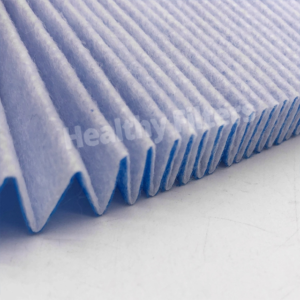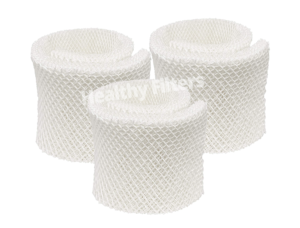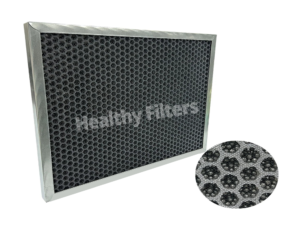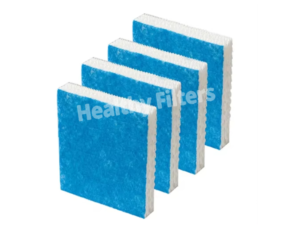V-Bank HEPA Filter is a high-performance air purification device that optimizes airflow distribution and filtration area through a V-shaped pleated structure. It complies with EN 1822 H13-H14 or ISO 16890 ePM1 99.95%-99.995% standards and is designed for industrial and medical scenarios with high air volume and high cleanliness requirements. With ultra-low resistance, high dust holding capacity and long life as its core advantages, it can intercept ≥99.97% of 0.3μm particles (such as viruses, bacteria, radioactive aerosols, etc.), becoming the ultimate filtration barrier for clean rooms, biosafety laboratories and high-end manufacturing industries.
Core structure and technical features
V-shaped pleat design
Multi-piece V-shaped arrangement: 4-12 groups of independent filter elements are combined in a V-shaped arrangement at an acute angle (usually 60°-90°), and the effective filtration area is increased by 3-5 times compared with the flat HEPA, significantly reducing the pressure drop (initial pressure difference ≤200Pa).
Filter material selection:
Glass fiber filter paper: high temperature resistance (≤350℃), chemical corrosion resistance, suitable for sterilization or industrial high temperature scenes;
Electret polyester fiber: electrostatic adsorption enhances submicron particle capture (MPPS efficiency ≥99.99%), and the initial pressure difference is lower.
Aluminum partition: serrated aluminum foil supports pleats to prevent filter material collapse, and withstands wind speed ≤4.0m/s.
Sealing and frame
Heavy duty metal frame: galvanized steel or stainless steel (304/316L), corrosion-resistant and impact-resistant, suitable for large air volume systems (≤10,000m³/h);
Silicone-free sealing: polyurethane casting or laser welding edge sealing, leakage rate ≤0.005%, in line with ISO 14644-1 clean room standards.
Core performance parameters
Parameters Performance indicators
Filtration efficiency 0.3μm particle interception rate ≥99.97% (H13) to ≥99.995% (H14)
Initial pressure difference ≤180Pa (@ rated air volume), energy consumption is 30%-40% lower than traditional HEPA
Dust holding capacity 200-800g/m² (depending on V-type depth and number of filter elements)
Temperature resistance Glass fiber type: -50℃~350℃; polyester type: -30℃~80℃
Applicable air volume 2,000-50,000m³/h (suitable for industrial centrifugal fans or clean room systems)
Core advantages
Advantage dimensions Application value
Ultra-large dust holding capacity Deep pleated structure extends the replacement cycle to 3-5 years (low dust scenario)
Energy saving and high efficiency Low initial pressure difference + uniform airflow distribution, system energy consumption is reduced by 25%-50%
Adaptable to extreme environments High temperature resistance, acid and alkali resistance, suitable for harsh scenarios such as pharmaceutical sterilization and semiconductor etching
Modular maintenance Independent filter element unit supports local replacement, reducing operation and maintenance costs by 30%
Typical application scenarios
Biomedicine:
BSL-3 laboratory, vaccine filling line, intercepting viral aerosols and microorganisms;
Freeze dryer, isolator exhaust system, prevent cross contamination.
Electronic manufacturing:
Wafer lithography area, Micro LED workshop, control 0.1μm particles, improve yield by 8%-12%;
Flexible screen coating equipment, prevent defects caused by nano dust.
Nuclear energy and military industry:
Nuclear fuel processing workshop, blocking the spread of radioactive particles;
Aerospace component clean room, maintaining a Class 100 clean environment.
Food and chemical industry:
Aseptic packaging line, lithium battery electrolyte workshop, intercepting metal dust and chemical volatiles;
High-precision weighing room, avoiding particle contamination of raw materials.
Selection and maintenance guide
Selection key
Cleanliness level:
ISO Class 3 (Class 10): Select H14 + stainless steel frame;
ISO Class 5 (Class 100): Select H13 + galvanized steel frame.
Pollution type:
High temperature/chemical corrosion: glass fiber + 316L stainless steel;
Conventional dust: electret polyester + lightweight aluminum partition.
Intelligent operation and maintenance
Pressure difference monitoring: The recommended replacement threshold is initial pressure difference × 2.5 (usually ≤450Pa);
Cleaning restrictions: No water washing or backwashing, independent V-type filter element needs to be replaced after clogging;
Replacement cycle:
Low dust scenario (laboratory): 3-5 years;
High dust load (electronics factory): 1-2 years.
Technological innovation and trends
AI dynamic tuning: integrated differential pressure sensor and fan frequency control, real-time optimization of air volume distribution;
Nanocatalytic coating: TiO₂ photocatalytic layer realizes the dual functions of particle interception and formaldehyde decomposition;
Circular economy design: detachable metal frame + recyclable filter material, reducing 90% of waste.
V-shaped HEPA filter reshapes the industrial filtration standard with “high dust holding capacity, low resistance and modularization”, becoming a reliable cornerstone for ultra-clean environment and harsh working conditions. From chip lithography to vaccine production, it protects precision manufacturing and life safety with innovative structural design, and promotes the evolution of high-efficiency filtration technology towards intelligence and sustainability.





